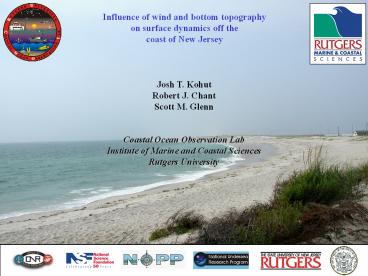Influence of wind and bottom topography - PowerPoint PPT Presentation
Title:
Influence of wind and bottom topography
Description:
Linear Wind Model. Rotate wind vectors according to complex ... Uwcor (x,y,t) = slope(x,y)*Uwind (t) U (x,y,t) = Uwcor (x,y,t) U (x,y,t) Linear Wind Model ... – PowerPoint PPT presentation
Number of Views:69
Avg rating:3.0/5.0
Title: Influence of wind and bottom topography
1
Influence of wind and bottom topography on
surface dynamics off the coast of New Jersey
Josh T. Kohut Robert J. Chant Scott M. Glenn
Coastal Ocean Observation Lab Institute of Marine
and Coastal Sciences Rutgers University
2
(No Transcript)
3
Annual Mean
4
Stratified Mixed
5
Time Series of Wind and Surface Currents
Mixed
Stratified
More coherent
Less coherent
Wind Velocity
Surface Current
6
Surface Velocity Structure
7
Surface Velocity Structure
Velocity Representation
U(x,y,t) U (x,y)
U (x,y,t)
Measured Velocity Mean
Residual
(Detided and Filtered)
8
Surface Velocity Structure
Stratified Water Column
Mean
Residual
Variance (cm/s)
- Flow across isobaths
- Alongshore windstress
- Major axes oriented alongshore
- Alongshore wind axis
9
Surface Velocity Structure
Stratified Water Column
Alongshore to the North
Mean
Residual
Variance (cm/s)
- Strong mean flow
- Major axes oriented alongshore
- Less energetic
10
Surface Velocity Structure
Stratified Water Column
Alongshore to the South
Mean
Residual
Variance (cm/s)
- Strong mean flow
- Major axes oriented alongshore
- Less energetic
11
Surface Velocity Structure
Mixed Water Column
Mean
Residual
Variance (cm/s)
- Flow along isobaths
- Cross-shore windstress
- Major axes have cross-shore
- component
- Wind ellipse is circular
12
Contribution of Wind Stress
Complex Correlation (Surface)
13
Wind Stress Complex Correlation
Complex Correlation
Stratified
Mixed
2 m/s
2 m/s
0.0 0.1 0.2 0.3 0.4
0.5 0.6 0.7 0.8 0.9 1.0
Correlation
14
Wind Stress Complex Correlation
Complex Correlation
Stratified Regime
Upwelling Favorable
Downwelling Favorable
5 m/s
5 m/s
18 20 22
24
0.0 0.1 0.2 0.3 0.4
0.5 0.6 0.7 0.8 0.9 1.0
Correlation
15
Contribution of Wind Stress
Complex Correlation (Depth)
16
Wind Stress Complex Correlation
Complex Correlation (Stratified)
Depth (m)
1.0
17
(No Transcript)
18
(No Transcript)
19
Wind Stress Complex Correlation
Complex Correlation (Mixed)
Depth (m)
1.0
20
(No Transcript)
21
Contribution of Wind Stress
Linear Wind Model
22
Linear Wind Model
Wind Stress Linear Model
- Rotate wind vectors according to complex
correlation - Remove the mean
- Calculate the slope and intercept of best fit
line
Uwcor (x,y,t) slope(x,y)Uwind (t) U
(x,y,t) Uwcor (x,y,t)
U (x,y,t)
Observed Correlated
Uncorrelated
23
Wind Stress Linear Model
Complex Correlation
Stratified Water Column
Mixed Water Column
2 m/s
2 m/s
0.0 0.1 0.2 0.3 0.4
0.5 0.6 0.7 0.8 0.9 1.0
Correlation
24
(No Transcript)
25
(No Transcript)
26
Wind Stress Linear Model
Stratified Regime
Measured Residual
Uncorrelated Residual
Variance (cm/s)
27
Wind Stress Linear Model
Mixed Regime
Measured Residual
Uncorrelated Residual
Variance (cm/s)
28
Contribution of Topography
29
Topography
Topography
Principle Component
Along-isobath
minimize
Depth (m)
h depth L horizontal scale
30
Topography
Uncorrelated Residual
Stratified
Mixed
-60 -40 -20 0
20 40 60
Angular Offset (degrees)
Negative angle Principle axis right of
topography
31
Topography
Influence of Gradient Maximim
Angular Offset
Depth Gradient (m/km)
32
Conclusions
- Annual mean flow is primarily along-isobath.
- Stratification
- strong mean currents and weak variability
primarily oriented - along-shore.
- surface currents are highly correlated with the
wind. - currents tend to be to the right of the wind at
the surface and - rotate the the left with depth.
- current fields uncorrelated with the wind are
generally weak - and not aligned with topography.
- Mixed
- strong variability with a cross-shore component.
- surface currents are less correlated with the
wind. - currents tend to be to the left of the wind at
the surface and - rotate slightly to the left with depth.
- surface current fields uncorrelated with the
wind resemble the - observed fields and tend to
follow topography in regions - were the gradient is maximum.
33
Acknowledgements
Naval Postgraduate School
Jeff Paduan
Coastal Ocean Observation Lab (R.U. COOL)
Sage Lichtenwalner, Liz Creed, Mike Crowley,
Clinton Haldeman, Chhaya Mudgal, Kristie
Andresen, Louis Bowers
Codar Ocean Sensors
Brigantine, NJ Long Beach Township, NJ
National Park Service, United States Coast Guard
34
Surface Velocity Structure
Mixed Water Column
Alongshore to the North
Mean
Residual
Variance (cm/s)
- Stronger flow near-shore
- Major axes oriented cross-shore
- component
- More energetic
35
Surface Velocity Structure
Mixed Water Column
Alongshore to the South
Mean
Residual
Variance (cm/s)
- Strong mean flow
- Major axes have cross-shore
- component
- More energetic over the bump
36
Topography
Mixed Regime
Measured Residual
Uncorrelated Residual
-60 -40 -20 0
20 40 60
Angular Offset (degrees)
Negative angle Principle axis right of
topography































